Orange County housing daydreaming – Home prices in Orange County to increase by approximately 50 percent by 2016 according to UCLA. Why that forecast will not come to pass and other delusions of bubble markets.
I was listening to a fascinating lecture regarding the Los Angeles real estate market by Dr. Robert Shiller, the creator of the often used Case-Shiller S&P Index that tracks the real estate market. The lecture was given back in 2008 at Yale and pertained to real estate finance. In one of his historical studies, he examined housing in Los Angeles back in the 1880s. What he found through various news clippings and other sources of information was a belief that Los Angeles was somehow the “promised land†because of the nice weather and general belief that it was somehow booming. Of course, prices peaked in 1886 and then crashed. In more modern times, he was able to survey people in 1988 in Los Angeles during another boom and once again, the typical Southern California sun induced delusion reared its head. The data is fascinating and we’ll tie this in with the Orange County real estate market as well.
What he found in 1988 was that those surveyed in Los Angeles thought that real estate prices would go up by 10 percent each year into the indefinite future:
So for many in Los Angeles at the time, the belief was that housing prices would double in 7 years versus 18 in Milwaukee (the 4 percent perception was closer to the overall inflation rate). Also, what was found in the survey was that 80 percent of those in Los Angeles feared being left out of the housing market if they didn’t buy today. This was very common in our last bubble and much more so since prices were going up sometimes 20 percent a year. There was also a sense of gambling with Los Angeles; 54 percent had a sense of excitement surrounding the real estate market versus 21 percent in Milwaukee according to Shiller’s research. Here is how the 1980s boom looked like:
Source:Â Calculated Risk
Now of course the 1980s boom looks like a walk in the park compared to the latest boom. But the seeds of delusion that were in place in the 1880s, 1980s, and 2000s all seem to carry the same tone. Los Angeles and Southern California carries a sense of glamour and is prone to major housing bubbles. You would think that after this insane bust that people would learn to curb their enthusiasm. Not so. In fact, the UCLA Anderson forecast on Orange County is a fascinating example of how enthusiastic people can be on a regional market. Let us look at the data.
UCLA Anderson forecast for Orange County
Now before we look at the 2010 forecast, we should say that their long-term forecasting hasn’t always been exactly on point:
“(December 2006) Despite the housing downturn, the California and U.S. economies are headed for a “soft landing” because trouble in one sector alone is not enough to trigger a recession, UCLA economists said in a quarterly forecast to be released today.
California could have a soft landing — slowing growth but without recession — as long as its economic woes are limited to the housing sector, economist Ryan Ratcliff said in the UCLA Anderson Forecast outlook.
In his California forecast, Ratcliff expressed concern about two aspects of the economy: consumer spending and the state budget. If problems develop in either area in conjunction with the housing slump, then the state could slide into recession, he said. But Ratcliffe concluded that neither of those scenarios was likely.â€
I think it safe to say that we had anything but a soft landing but wanted to give you a sense before we present the pie in the sky numbers for Orange County:
Source:Â OC Register, UCLA forecast
Now this is just stunning. It reminds me of the 1988 survey of Los Angeles residents saying they expect to see 10 percent annual appreciation in real estate prices. In the next six years according to this survey, prices should go up by 49 percent for the entire county. So that million dollar Seal Beach home should then be worth $1,490,000 in 2016. Not only does this forecast seem unlikely, when we chart it out it seems preposterous:
The red line shows were reality ends and to the right, fantasy begins. Given the great state budget we have right now and unemployment situation, why are they predicting home price hikes that are reminiscent to the heyday of the housing bubble? This is their reason:
“(OC Register) Expect a sluggish housing market for the remainder of this year and into next spring,†the forecast states. “At that time, pent up demand, rising affordability, and dissipating fear of a faltering economy should push sales higher.â€
In other words, they are just speculating. This is like betting on red coming up on Roulette.  First, rising home prices mean home prices become less affordable as they go up unless income also goes up (we don’t see how this is the case in the forecast). The only reason the bubble occurred in the first place was that toxic mortgages gave the illusion of affordability with teaser rates and artificially low interest rates. Next, this “fear†is actually tethered to reality. The state budget is in a mess. The employment market is incredibly weak. And this notion of pent up demand is bunk. Mortgage rates are at historically low levels. There is inventory on the market and it is pent up supply (shadow inventory) that is keeping prices inflated at the moment but that can’t last forever.
The forecast also doesn’t talk about the biggest cost in real estate building and that is labor. As we know with the squeezing out of the working and middle class, labor is abundant and cheap especially in the state because of the bust in the construction industry. Incomes are stagnant. So why would home prices soar 49 percent in 6 years? Even inflation is weak at the moment:
Source:Â BLS
In the last couple of years, inflation has oscillated from a negative rate to 2.5 percent annually. That does not translate to a 49 percent increase in six years. Every county in Southern California seems to be chasing past returns and expects the days of the bubble to come back. Maybe it is the sun that causes all these booms and busts.
Did You Enjoy The Post? Subscribe to Dr. Housing Bubble’s Blog to get updated housing commentary, analysis, and information

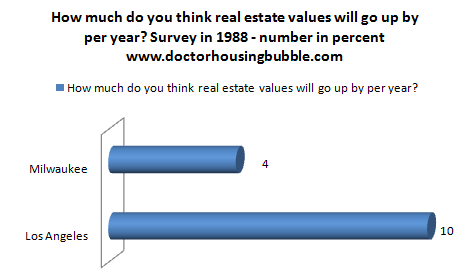
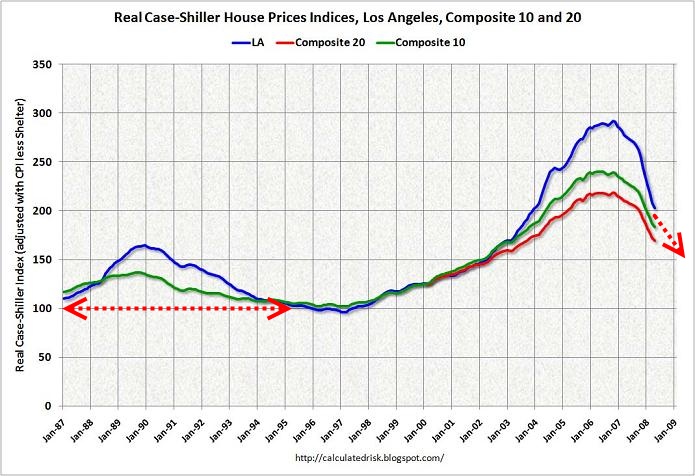
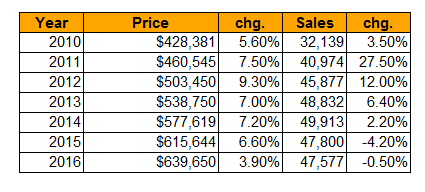
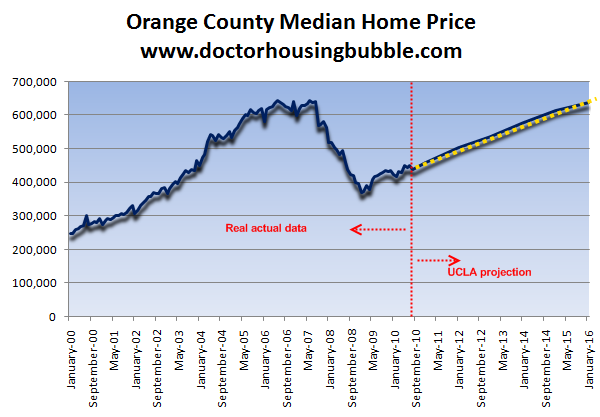
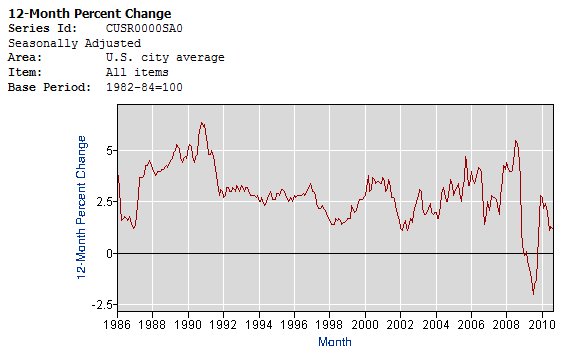
 Did You Enjoy The Post? Subscribe to Dr. Housing Bubble’s Blog to get updated housing commentary, analysis, and information.
Did You Enjoy The Post? Subscribe to Dr. Housing Bubble’s Blog to get updated housing commentary, analysis, and information. Subscribe to feed
Subscribe to feed






44 Responses to “Orange County housing daydreaming – Home prices in Orange County to increase by approximately 50 percent by 2016 according to UCLA. Why that forecast will not come to pass and other delusions of bubble markets.”
There is one chance for that to happen-if the dollar collapses completely. Then we will be like Zimbabwe , where a loaf of bread costs a million Zimbabwe dollars give or take a few hundred thousand.
Otherwise in this environment not likeley. The dems don’t have a clue and it looks like the even more free trade and deregulation party/republicans is coming back to power-it should be a fun decade-not.
A similar survey was taken in 2005, by the Economist. Los Angeles homebuyers were asked how much they thought their new homes would increase in value over the next 10 years. Their answer: 22% per year
22% per year! There’s your problem. That housing being used as a commodity mentality is finally being wiped out the human genome. About time.
UCLA used to have a great basketball team. Now they don’t. UCLA used to have a good economic forecasting department. Now they don’t. Things change.
Maybe the basketball team is doing the forecasting???
Yeah. It looks like it. We need Johnny Wooden back.
You are right. As a USC person, I would not trust UCLA. Nobody knows the future.
Ha ha ha!! I love it!!! I’m a fellow USC allum as well.
it’s all about the psychology, silly.
over pricing is primarily based on people’s optimism/enthusiasm for an asset class.
houses will be affordable when people buy a house simply for living, with no expectation of real price appreciation.
we are not anywhere near this point. too many people, especially uneducated home buyers, incorrectly view a home as an excellent investment and end up overpaying.
when there’s no interest in a home as an investment, and homes are no long front page news, we will have finally hit bottom.
it’s clear we have a long way to go. too many bubble blogs(as much as i love them), too many front page news stories, too many tv stories. too many conversations about home prices among my friends and acquaintances. there’s still too much interest in the residential real estate asset class right now.
i expect this group-think will change slowly. probably 10 years or longer where people in socal or norcal buy a home simply to live. where no one talks about homes ad nauseum. only then will we see a return to sanity.
again, it’s all about the psychology.
Relevant: http://en.wikipedia.org/wiki/Shift_key
Also: http://en.wikipedia.org/wiki/Capitalization
no
I think the forecast in baking in 6 to 7 percent inflation. With QE2 on the horizon this is very possible.
QE I didn’t cause 6-7% inflation, why would QE II? QE I was in excess of $2T, and QE II is estimated at $500B. Where is the inflation right now? For QE II to result in 6-7% inflation, two things would need to happen: 1) the Congress would need to deficit spend at much greater levels (already at ~$1.5T per year), and 2) that money would have to work its way into the economy (QE I didn’t, it’s still sitting in reserves at the FED).
From whence the inflation, pray tell.
And, even if there is inflation, how well does that historically correlate with rising home prices? Short answer – not well. High inflation means higher food and energy prices and higher interest rates. Higher food and energy prices result in less discretionary income, which result in less money to pay the mortgage.
Higher mortgage rates are really a deflationary phenomenon, in regards to housing prices, because it results in a contraction in borrowing power – i.e. more money is spent in frictional servicing costs instead of higher home prices.
Besides, the goal of QE II is to keep the interest rates low in order to support current housing price levels. Unless the FED can drive the mortgage rates even lower than 4%, the housing prices won’t rise. And since the FED is up against the zero bound for the target and discount rates, there isn’t much room left to maneuver. The only thing the FED can do is buy intermediate maturity treasuries (7 to 10 yr) to drive down the 30 yr mortgage. Even if the 10 yr note drops to 2% (for 10 yrs!) there is a risk premium of typically 1.5% on top of that for 30yr mortgages. The best that the FED can hope is that enough borrowers default out of their unaffordable mortgages, and new buyers take over the debt at low rates, thus keeping the prices high (and protecting bank capital, which is what this is really all about).
Try looking a few steps ahead instead of simply parroting the mass media morons.
Thank you. Logic is always welcome.
While that could possibly cause an increase in the posted price of the property, it would not make it any more affordable, nor would it be due to a boom in the market. We would have increasing prices and a population without the means to afford. I suppose it’s possible these properties could be bought up by investors from other countries with stronger, more stable currencies, but they also have the entire world to invest in, so I don’t know why they would specifically choose Orange County real estate. My opinion, of course.
The UCLA professors who wrote their unfactual and speculative article live and die in the academic world of publish or perish. The professors overwhelming desire to write papers overwhelms any sense of common sense or historical data review. Unfortunately for all of us, the UCLA professors have published an awful article with the public’s money (our tax money!).
yawn.
Orange County home prices to increase by 50% by 2016. That’s funny. Looks like they are pretending that prices will go up, just like I’ll be pretending I’m someone else tonight when I’m wearing my Halloween costume. That cracks me up.
Lately, I haven’t been overly impressed with the quality of health care at UCLA either.
Cedars Sinai FTW!
If you look at a historical trend of unemployment as it correlates to housing prices in CA, you will see that it’s very strong. Any unemployment over 7% will mean a flat to decending real estate market. At 12%+, we will be waiting a while longer yet to see price increases.
keep dreaming, most now are up to there head in debt or taped out they have sucked the marrow out of everybody. Most collage kid are in the same boat………… The only reason the bubble occurred in the first place was illusion of affordability with teaser rates and artificially low interest rates. Bum could even get loans back in the day…………
Ameriquest II: The Wrath of Con
People need to come to terms with the fact that houses aren’t atms anymore. I live in a county that leads the nation in percent change of foreclosures and I see it everyday on my walks. These idiots can’t accept the fact that their not gonna make money selling their house. I saw a house today asking five hundred grand, that house like all the rest will be on the market for years and then finally foreclosed on.
There is only pent up supply. Each time sales increase the supply that comes back on the market is huge. Then it wanes when above median price sales dont pick up. But bidding wars are back in vogue in some choice locations….but those are for homes priced very low to encourage speculation. As you say, amazingly similar to past busts.
I enjoy your blog!
Cheers, Chris
Just hilarious !
The only thing more preposterous than these projected house price increases is the images that come to my mind trying to invent an economic scenario that would permit them.
Then I reflect: isn’t this just the flipside fantasy of the emerging global reality?
http://artsytime.com/life-in-slums-of-mumbai/
If the inflation is up to 20% in the next 5 years, and housing price will go up to that much. The food price will go up 2000%. Hyperinflation is not inflation per se, and it is an exponential inflation.
Nobody really wants hyperinflation, and it is the results of incremental and accumulative inflation.
“California is growing slowly, but is laying the groundwork for faster growth in 2011 and 2012,” said Jerry Nickelsburg, senior economist at the UCLA Anderson Forecast.
In previous downturns, such as those related to aerospace in 1991 and technology in 2001, employment typically took four to six years to recover, he said.
Some sectors of the California economy are showing signs of recovery. Seaports are experiencing an uptick in traffic. Exports are increasing because of demand for the state’s products in Asia. Foreign tourists are returning to California, according to data on international arrivals from Los Angeles International Airport and San Francisco International Airport.
The construction sector remains a major drag on the recovery. Building permits are at record lows. But with the state’s population continuing to grow, pent-up demand for housing could lead to an increase in construction activity — and hiring — in late 2011, the forecast predicts.
http://articles.latimes.com/2010/sep/15/business/la-fi-0915-ucla-forecast-20100915
If one likes to read anecdotes from the housing bubble in LA in 1880-ies, there is a book written in 1944:
The Boom of the Eighties in Southern California by Glen Dumke.
There is also a bunch of numbers to slog through while getting to anecdotes, but some of the numbers could be interesting too.
Unemployment extensions are set to expire end of November. Wish I had better demographics on those affected, but just as a generalization, losing these benefits will further decrease overall spending and less “economy stimulating”
Here’s another one…
CSUF: Home prices up 2%-4% in ‘11
http://lansner.ocregister.com/2010/10/31/csuf-home-prices-up-2-4-in-11/86374/
UCLA? Damm they are always off the charts….. University of Caucasian Lost among Asians!!!
Caucasian???? What has that to do with anything? African-American lost among the Mexicans? What what what?
Here’s an interesting flash of cold water on housing prices rising maniclly in the next five years from the San Diego Union Tribune:
“Personal income slid by 0.1% in September – the sharpest drop in 14 months – partly because of a $4.8 billion decline in government salaries, as state and local agencies cut back their payrolls for the fourth month in a row in response to rising budget deficits.
“The good news is that consumers are spending but not nearly enough to get this very sluggish recovery some traction,” said Chris Christopher Jr., senior principal economist at IHS Global Insight, an economic analysis firm.
Christopher added that “the government payroll and employee reductions are taking their toll on income and, therefore, mitigating consumer spending growth.” ”
I wonder what state leads the nation in govt cut backs for employees? Could it be California?
One thing that is not in short supply is ignorant Americans. They don’t like math, think we have skills and talents no other nations have, and are of the opinion that if they believe it can happen, it will. I guess as long as we can print money and other countries accept it, the game goes on. There is no obvious, rational reason why things got this far detached from fiscal reality, so who can say how far this thing goes. But if it finally stops…hitting the fan will become a fecal matter.
When I read this drivel in the Register I got a good laugh for the day. Unless we have hyper inflation, sub prime II, or somehow the economy does a 180 and we have 4% unemployment again…the 50% percent rise in 6 years is absolutely impossible. I simply can not fathom the typical 1400 sq ft shitbox in HB (miles from the ocean) that goes for 600K today will go for 900K in 6 years.
The CA real estate kool-aid truly is stronger than heroin. The only way to kick this habit is to go cold turkey and endure lots of pain. The withdrawal symptons will be with us for years to come!
I have just given up all hope for those closet children at UCLA…with America on the brink of Civil War and the dollar collapse…it will be over a decade before we EVEN think about home prices coming back…
Dear UCLA, didnt the riots on your campus about higher tuition give you a signal of
what is taking place in America?
They forgot to mention fast food workers will make $30 an hour; now it makes sense! Check out the price of any commodity today. Cotton hit a record high, highest price since the Civil War. Inflation? Surely, price increases won’t be passed onto consumers; not with 20%+ un/underemployment. Move along folks, there’s nothing to see here!
Bashing UCLA is really mature based on the published work of a few economists. It’s a great school and I’m sure most people who live in California would be happy to have their child attend there. I’m a Bruin, full disclosure.
Home prices will not come back based on what the Doc has shown us here. Let the knifecatchers do what they want and ignore the report. Hopefully in a decade I’ll look back on this blog and see how people here have successfully purchased homes in good areas for their families at a reasonable price.
Quantitative Easing I followed the bursting of the subprime bubble in the summer of 2007. The biggest effect was to drive up the price of gasoline to almost $5 per gallon in June 2008, which just killed home prices in LA’s long-commute exurbs. And that collapse of exurban home prices is what set in motion the collapse of Fannie/Freddie and Lehman in September 2008.
So, how is Quantitative Easing II going to make people want to buy all the foreclosed homes in Lancaster and Lake Elsinore? I mean, I could see how high gas prices could do inner suburbs like Studio City and Pasadena some good by making them more desirable than exurbs, but I can’t see how printing money solves California’s main housing problem: the exurbs.
@DHB – your graph is wrong: http://www.doctorhousingbubble.com/wp-content/uploads/2010/10/ucla-housing-forecast-orange-county-2016.png
You are showing a linear climb in prices after 2010. The data the Anderson study is showing is closer to 2^x (but definitely below that) in 2011 and then tapering off quickly over the next couple of years. My guess is that they “predicted” QE2 and are assuming/betting that it will create another short term bubble…they are just PC, so that they get their funding.
They were smoking the crack pipe on those future projections at UCLA living the fantasy that many people did in this real estate market, everyone wanted to make a quick buck and the jig is up. The bottom has dropped out, no one wants to accept the grim reality that in California the homes are now Valueless. The reality of it is, the if you were the Farmer and your daughter got pregnant by the salesman who needed a place to stay and skipped town. It’s to late.
What what what? Does anyone write in English? NO???
What what what?
Leave a Reply